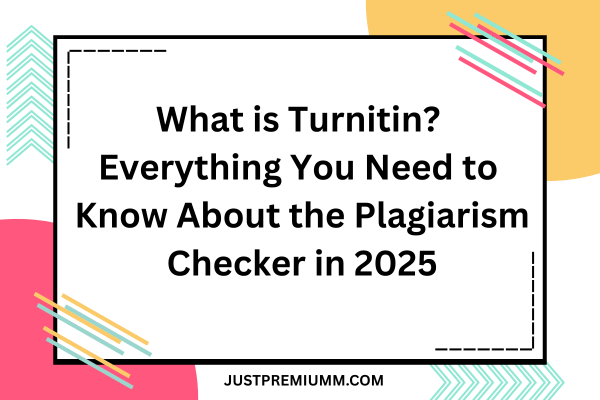In today’s digital academic world, originality is more important than ever. Whether you’re a student, educator, or content creator, ensuring your work is free of plagiarism is not just a best practice—it’s a necessity. That’s where Turnitin comes in. Widely regarded as the world’s most trusted plagiarism detection software, Turnitin has become a staple in schools, colleges, and universities around the globe.
In this article, we’ll explore what Turnitin is, how it works, why it’s important, and how to use Turnitin effectively in 2025. Whether you’re a first-time user or looking to optimize your experience, this guide has everything you need.
What is Turnitin?
Turnitin is an online plagiarism detection tool designed to identify unoriginal content in academic writing. Used by over 15,000 institutions in 150 countries, Turnitin scans student submissions against a vast database of:
-
Academic publications
-
Student papers previously submitted to Turnitin
-
Internet content, both current and archived
-
Licensed commercial and educational content
Unlike other free plagiarism checkers, Turnitin does more than compare words. It evaluates sentence structure, grammar, writing style, and even intent to detect intentional and unintentional plagiarism.
How Does Turnitin Work?
Turnitin uses proprietary matching algorithms to analyze the originality of a submitted document. Here’s a step-by-step breakdown of how Turnitin works:
-
Submission: A student or teacher uploads a file (Word, PDF, Google Docs, etc.) to the Turnitin platform.
-
Scanning: The document is scanned and compared against Turnitin’s extensive database.
-
Similarity Report: The system generates a similarity index, indicating the percentage of content that matches other sources.
-
Originality Report: The tool highlights matching passages and provides direct links to the sources.
-
Feedback & Grading: Teachers can leave comments, grade using rubrics, or request revisions directly on the Turnitin platform.
This process typically takes less than 5 minutes, making it fast and effective.
Key Features of Turnitin
Turnitin offers more than plagiarism detection. Here are some of the key features:
1. Similarity Index
Displays a percentage score that reflects how much of the content matches other sources. A high score doesn’t always mean plagiarism—but it does require review.
2. Originality Report
Highlights and color-codes sources of matched content, offering detailed insight into potential problem areas.
3. Peer Review Tools
Students can review each other’s work anonymously using Turnitin’s peer review features, promoting collaborative learning.
4. AI Writing Detection
New in 2025, Turnitin has integrated AI detection technology to flag content generated by tools like ChatGPT, Bard, or Jasper.
5. Feedback Studio
An all-in-one environment for providing comments, grading, and creating rubrics for fair assessment.
Is Turnitin Accurate?
Turnitin is one of the most accurate plagiarism detection tools on the market, but it’s not flawless. While it catches most types of direct plagiarism and paraphrasing, it may not detect:
-
Translated content
-
Plagiarism from non-indexed sources
-
AI-generated content with unique phrasing
Still, Turnitin remains the industry standard, widely trusted by educators for its depth and reliability.
Benefits of Using Turnitin
For Students
-
Ensures academic honesty
-
Improves writing skills
-
Provides feedback before submission deadlines
-
Helps avoid accidental plagiarism
For Educators
-
Saves time in checking originality
-
Encourages a culture of integrity
-
Provides grading tools and analytics
-
Detects patterns of misconduct
How to Use Turnitin as a Student (Step-by-Step)
-
Log in to your institution’s Turnitin portal (or via Moodle, Canvas, Blackboard, etc.)
-
Navigate to your assignment.
-
Upload your file.
-
Click Submit.
-
Wait for the similarity report (usually available in minutes).
-
Review the report and revise your work if necessary before final submission.
💡 Tip: Always write your paper from scratch and cite sources properly to avoid detection.
Turnitin and AI Content in 2025
With the rise of AI tools like ChatGPT, Turnitin has updated its algorithms to detect machine-written content. Its AI writing detection feature flags unnatural patterns, abrupt tonal shifts, and statistical markers of non-human writing.
Is AI-generated content always flagged?
No. If the AI content is rewritten with a human tone, cited properly, and edited thoroughly, it may pass detection. However, academic institutions increasingly consider AI-generated work without proper disclosure as misconduct.
FAQs About Turnitin
Can Turnitin detect paraphrasing?
Yes, to an extent. It can detect poorly done paraphrasing and similar sentence structures.
Does Turnitin keep student papers?
Yes. If enabled by the institution, Turnitin stores submissions in its database to prevent future plagiarism.
Is there a free version of Turnitin?
Turnitin is not free to individuals. Access is typically granted through schools or universities.
Can I check my paper before submitting?
Some institutions allow multiple submissions to see the report before finalizing. Ask your teacher for clarification.
Final Thoughts: Is Turnitin Worth It?
Absolutely. Whether you’re writing a term paper, thesis, or research article, Turnitin provides peace of mind and ensures you’re maintaining the highest standards of academic integrity. In 2025, with AI content on the rise and academic scrutiny at an all-time high, Turnitin is more relevant than ever.
Make it a habit to check your work before submission, cite sources correctly, and use Turnitin as a learning tool, not just a detection service.

